| Reviews & Columns |
|
Reviews DVD TV on DVD Blu-ray 4K UHD International DVDs In Theaters Reviews by Studio Video Games Features Collector Series DVDs Easter Egg Database Interviews DVD Talk Radio Feature Articles Columns Anime Talk DVD Savant Horror DVDs The M.O.D. Squad Art House HD Talk Silent DVD
|
DVD Talk Forum |
|
|
| Resources |
|
DVD Price Search Customer Service #'s RCE Info Links |
|
Columns
|
|
|
Star Wars Trilogy
I distrust hype. Praise a movie to the skies, and I'll look at it twice as skeptically. Show me a trailer a million times and I'll probably just stay away from the theater. Tout a trilogy of films as the greatest moviegoing experience of a generation, and I'll say "Let me judge that for myself." And as a reviewer, I'm never afraid to "call it like I see it," even if that means taking the opposite position to every other viewer and reviewer out there.
So I got the chance to review the Star Wars Trilogy, quite possibly the most eagerly anticipated DVD release in the history of the format, and the darling of my generation. If there were ever a situation with unsupportable hype, this is it. And do you know what?
These are great films.
There was nothing like Star Wars when the first installment hit the screens in 1977. Sure, there had been science fiction films before, even great ones like 2001: A Space Odyssey or Planet of the Apes, both in 1968. There were action sci-fi serials like Buck Rogers or Flash Gordon, and television shows like Star Trek or Doctor Who. For fantasy, there were the stop-motion animated spectacles of Ray Harryhausen. But Star Wars took an astonishing leap forward: there really was nothing even remotely like it.
What was so ground-breaking about Star Wars? First and foremost, I'd argue that it's a phenomenally successful blending of science fiction and fantasy, something that hadn't been done before and, in truth, has not really been done since. Star Wars is not really "science fiction" in anything other than its superficial trappings; it is really a fairy tale. And it's deliberately so: George Lucas drew on basic elements of mythology to craft his tale, drawing insights and inspiration from Joseph Campbell, who had explored the nature of the mythological hero figure in The Hero with a Thousand Faces.
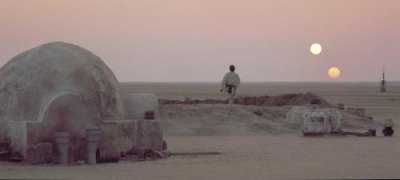
It's that mythological base that makes the story arc of Star Wars work so well, particularly with younger viewers. Luke Skywalker is the hero, but he's an Everyman kind of hero: a farm boy who discovers that he is the heir to an amazing legacy, and who is catapulted unprepared into a story of galactic proportions. As the most naive of the characters, he shares our wonder and amazement as he discovers the world beyond his limited horizons. Shrewdly, though, Lucas made Skywalker very much a functioning part of his universe: while the audience may be amazed at things like droids, hovercraft, and weird aliens, Luke takes them as a matter of course, because they're part of his normal surroundings.
Everything about the epic Star Wars saga has its roots in myth and fable. The enemy is the Empire, with its chilling ranks of armored, faceless Stormtroopers; the good guys are the rebels fighting for freedom. You might think it's odd for the Republic to be represented by a princess, but in fairy tale and myth, royal blood and essential goodness go hand in hand. But as with Luke, George Lucas wisely gave Leia a modern touch to make her more than just an archetype: she's no passive sit-in-a-tower princess, but a true leader of her people. 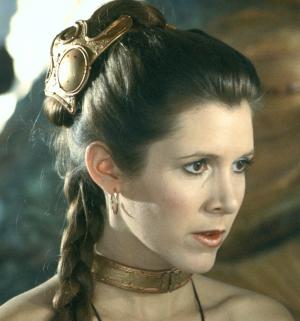 And let's not forget Darth Vader, who embodies all that is dark and frightening about human nature: a dark side that Luke (like us) cannot simply destroy, but must come to terms with.
And let's not forget Darth Vader, who embodies all that is dark and frightening about human nature: a dark side that Luke (like us) cannot simply destroy, but must come to terms with.
What's perhaps most interesting about this blend of fantasy and science fiction is that it still remains essentially unique; while many films and television shows were immediately inspired by the science-fictional elements and the sweeping story arc, the fundamental concept of blending the two genres still remains largely the province of Star Wars. That continuing uniqueness is one reason why the three original Star Wars films retain their storytelling power. Think of The Lord of the Rings, in contrast: the original novel was utterly ground-breaking when it was published in the 1950s, but its influence was too profound for its own good. After reading and watching so many stories that were influenced by Tolkien's work, it's almost impossible to experience The Lord of the Rings as having the same power as when it first came out. Not so with Star Wars, which still has its original freshness.
In terms of narrative structure, the three Star Wars films are deftly crafted. We start out "in the middle of things" as C-3PO and R2-D2 escape with Princess Leia's message, giving us a taste of the thrills to come. It doesn't overload us, though, because immediately afterwards we shift to the quieter scenes of Luke tending the farm and dealing with ordinary life (although it's still far from truly "ordinary" to the viewer). From here on, we add new complications and new characters at a steady but never overwhelming pace: as we meet Obi-Wan Kenobi, Han Solo and Chewbacca, Yoda, Lando Calrissian, and the Emperor, each new element layers on over the preceding ones to build a more and more engaging story. As Luke learns more about himself and his place in the galaxy, so do we... which makes our attachment to him, the Everyman character, all the stronger.
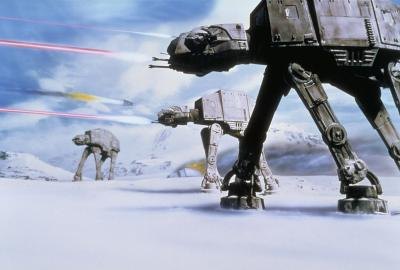
The story is far from the only reason why the Star Wars films succeed the way they do. Lucas' vision of the Star Wars universe is extraordinarily original even now, and certainly even more so when we consider the paucity of comparable material in 1977-1983. The worlds of the films – even the fact that we're talking about worlds, plural – offer a fresh and wildly imaginative universe that practically begs the viewer to imagine himself a part of it. While we might justifiably poke fun at the "single-climate planets" (a desert world, a snow world, a jungle world), we do get a richly textured society, developed primarily through the visual elements of the film: the varied alien races, their wide assortment of technology, the weird flora and fauna of each place, and so on.
It's not just the breadth and depth of Lucas' imagination that makes the Star Wars universe work... it's how he presents it. Lucas tells his story without explaining or showcasing the world it's set in: we see what we see when (and if) it becomes part of the story, and only to the extent that it is part of the story, whether it's the Mos Eisely spaceport, Cloud City, or the iniquitous den of Jabba the Hut. There are countless really neat details about the Star Wars universe, but what makes them work is that they remain in the background where they belong. Lucas never shoehorns in any "As you know, Bob" dialogue to explain things like droids; they're just there, and taken as a matter of course by all the characters, just like we take a telephone or a laptop computer as a matter of course. This approach is remarkably effective in creating the sense of an expansive world that extends beyond the fringes of the movie set, and it has been used to good effect in other films, particularly ones like Alien that were specifically influenced by Star Wars, but like the blending of fantasy and science fiction, it doesn't show up in other genre films to the extent that we might have expected.
Any discussion of the influence of Star Wars would be incomplete without mentioning the innovation of the "used future," which is one element that has certainly had a profound influence on subsequent science fiction. Unlike the plastic-and-steel sterility of earlier science fiction worlds, Star Wars looks grubby. The equipment is beat-up, places are dirty and messy, people have worn and grubby clothes. In other words, the universe of Star Wars looks lived-in, and that adds a tremendous amount to its depth and believability. I love Star Trek, but to be honest, when Scotty or Geordi is desperately trying to fix something-or-other in the engine room, it never has the same gritty feeling of realism as when Han Solo is jerry-rigging the Millennium Falcon. Star Wars would be noteworthy for this visual innovation alone, even if it weren't such a success on all its other levels.
And in the end, what it comes down to is that the three Star Wars movies are lots of fun. Influence and significance aside, they tell a gripping and entertaining story that sucks you in from the very beginning and doesn't ever let go. I haven't addressed the films individually in this review because in all the ways that really matter, the Star Wars trilogy is one piece. A New Hope, The Empire Strikes Back, and Return of the Jedi all have different things to offer in terms of excitement and discovery, but the reasons why they work so well are common to all three films. I'm not even going to profess any favorites here: all three films are well paced, and all three build progressively on the story and characters to a satisfying climax. I am without a doubt in the minority when I say this, but I even think the Ewoks are perfectly OK in Return of the Jedi: a little silly perhaps, but not, I think, overdone. (For those who feel otherwise, the game Star Wars: Battlefront will be to your liking: apparently you can kill Ewoks in it.)
This review wouldn't be complete if I didn't address the issue of "special edition versus original edition." In a nutshell: the fact that we're seeing just the special edition is the reason this set is half-a-star short of a perfect five stars for content. I truly appreciate the restoration that has been done to the films, and I wouldn't trade the special-edition restored versions for an unrestored original version... but I wish these were the original cuts of the film, because I don't think the added material is good enough to justify messing around with the film that a whole generation knew and loved. On the other hand, I don't think the changes really hurt the films, either, and in fact some of the added visual details do add to the depth and texture of the story world as intended. 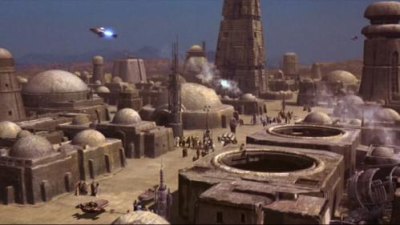 In any case, what's abundantly clear is that this version is what George Lucas really wants us to see... it would be silly to let dissatisfaction over a few relatively minor changes spoil our enjoyment of a truly phenomenal story. My praise for Star Wars holds true for the "special edition" just as much as much as for the original... and probably more so, in truth, now that improved technology has allowed Lucas to effectively erase the once-visible line between "real" and "special effect."
In any case, what's abundantly clear is that this version is what George Lucas really wants us to see... it would be silly to let dissatisfaction over a few relatively minor changes spoil our enjoyment of a truly phenomenal story. My praise for Star Wars holds true for the "special edition" just as much as much as for the original... and probably more so, in truth, now that improved technology has allowed Lucas to effectively erase the once-visible line between "real" and "special effect."
What's the final verdict? These are great films. They're important for their place in film history, to be sure, but more importantly in my view, they're fun to watch, transporting us to a different place and time and drawing us into an exciting and compelling adventure story. There's a reason why Star Wars has lodged itself so deeply in popular culture: it's fantastic.
The DVD
The Star Wars Trilogy is a four-DVD set: one DVD per film, plus a fourth for the bonus material. Each disc is packaged in a single keepcase, which fits into a paperboard slipcase. A slightly sturdier glossy paperboard outer slipcase fits over this case, making for an overall very attractive presentation, as the outer case's artwork features an embossed Darth Vader face on one side and the group of main characters on the other, all drawn in a stylized manner. I'm very pleased to see Fox go for practical, easy-to-access packaging rather than trying to create some weirdly inventive new way to hold the discs; the set looks very nice, it's easy to handle, it's convenient to be able to take out the individual films in their own cases, and it will fit nicely on the shelf.
Each DVD has an insert sheet with the chapter stops (for the films) and the content of the bonus material (for the fourth disc).
For those who like fancy menus, the Star Wars DVDs are sure to please. Each DVD has its own specially designed animated menu with its background drawn from the planets visited in that film. For each menu, there are three different "planet style" options: you'll get a different one randomly each time you boot up the DVD. The menus themselves are animated with shots from the film; there are some spoiler images but nothing too bad. It's easy to navigate, as the menu selection text is clear and easy to read.
I am very pleased to report that all of the menu animations are entirely skippable, so once you get tired of admiring them, you can proceed swiftly to the actual content.
Video
With all the fanfare surrounding the release of the Star Wars DVDs, you would naturally expect a flawless transfer, and I'm pleased to report that the Star Wars Trilogy lives up to nearly everything we might expect.
Each of the films is presented in its original 2.35:1 widescreen aspect ratio (at least if you get the widescreen version: there's a pan-and-scan release as well. Ugh. Look for the word "widescreen" printed on the spine of the case to identify the right version.). All three are anamorphically enhanced.
Across all three films, the new and painstaking restoration process allows us to see the material in all its glory; it's not even remotely exaggerating to say that these transfers are far better than anything that was ever shown in the theaters, whether in 1977 or 1997. The prints are impeccably clean, with not even the tiniest bit of noise or particle of dirt appearing in the image. (If that doesn't sound impressive, take a look at the image as it appears in the trailers: you'll be shocked at how awful it looks.) In some scenes, a very small amount of grain is perceptible, more so in Episode IV than in the other two, but I think we're looking at the ultimate limitations of the source material here.
Colors are certainly a high point of the new transfers. Everything looks bright and vibrant, but not too much so: the world of Star Wars is still a grimy "used" future. But where we're supposed to get color, it looks fantastic, from C-3PO's golden droid skin to the blue of a cloudless sky. Skin tones are always natural-looking, with none of the brownish tint that so often creeps into 1970s-era films. Whites are stunningly clean and white, even in extremely challenging scenes like those on the snow-covered planet of Hoth, and blacks are always richly dark. 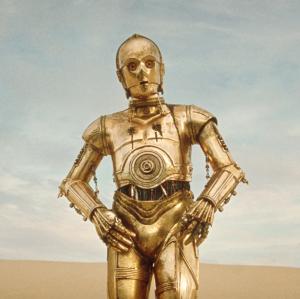
One especially pleasing aspect of the transfers is how seamlessly all the footage blends together. The footage added in 1997 for the special editions is so smoothly integrated that it's impossible to notice it; regardless of your thoughts on the merits of adding that material, in terms of the visual integrity of the material it's impeccable. On the other end of the time scale, the original special effects shots have been treated amazingly well in the restoration. Because of the way that the special effects were created (using multiple layers of film), they inevitably showed more flaws and wear than the rest of the print; viewers will also recall the blocky matte outlines that surrounded the ships in the space shots. All those special-effects-related flaws have been gracefully corrected: even with a highly critical eye I couldn't catch any indications that the shots were anything but "live action." In this case, the visual seamlessness of the films adds considerably to the enjoyment of the story, reducing almost to zero the potential moments where suspension of disbelief is shaken. (There are still those puppets in the cantina, but hey, they have their own charm.)
A nice side effect of the cleaned-up space shots is that, without the distraction of matte lines, it's a lot easier to appreciate the spectacular special-effects cinematography. The battle scenes in particular make impressive use of all three dimensions, which is something that's rare to see in science fiction films even now.
To be entirely accurate, I'll point out that the transfers aren't absolutely perfect. Star Wars Episode IV: A New Hope doesn't look quite as pristine as the two sequels: the image tends to be very slightly softer, and some of the dimly-lit scenes look a bit too dark in some areas of the image. That's really to be expected, though, given that this film is older than the others. The one real flaw is the presence of a small amount of edge enhancement in all three films. It's only apparent in a few scenes where there's high contrast between foreground and background, and it's minor as far as edge enhancement goes, but it didn't need to be there at all. Even so, considering that the transfer of The Phantom Menace was butchered by edge enhancement, the minimal presence of edge enhancement in Attack of the Clones and now this release is a huge step forward for Lucasarts.
Audio
Viewers have the choice of a Dolby 5.1 or a Dolby 2.0 soundtrack for each film. (A dubbed Spanish 2.0 and French 2.0 track are also included.) While the Dolby 2.0 option is very good for a basic surround track, offering a clean and pleasing listening experience, the 5.1 is what you'll want to choose if you have the setup for it. English subtitles are also included.
The Dolby 5.1 track offers a lovely, detailed audio experience, with a pleasing sense of depth to the sound quality in all three films. Dialogue is consistently crisp, natural-sounding, and well balanced with the track as a whole... and of course, unlike a tame dialogue-based film, the Star Wars movies are loaded with nifty audio special effects, all of which sound fantastic. John Williams' unforgettable score fills the speakers with a rich, full sound that complements the film perfectly; this is one set of movie soundtracks that's truly worth listening to purely on its own merits.
Of the three films, A New Hope makes the least use of specific surround effects; the overall sound is nicely balanced across all the channels, creating an immersive audio experience, but there aren't many instances of discrete effects being placed to the side or rear channels. All that changes in The Empire Strikes Back and Return of the Jedi, both of which have phenomenal surround sound. From environmental noises like wind, to blaster shots whipping right past your ear, the audio mix in the second and third films really does a superb job of placing the viewer in the midst of the movie action.
One thing that's constant across all three films is how effectively the soundtrack uses bass: your subwoofer will see a workout in any of the space battles. The deep rumble of the battleships gets right into your bones, and there's a definite bass punch to the more powerful weapons. Not only do the Empire's ships look impressive, they sound that way too.
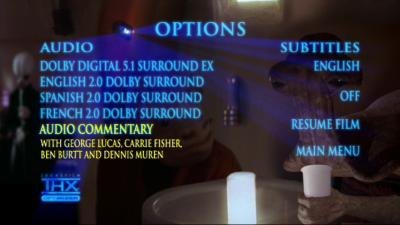
The only quibble I have with the soundtracks is that I think they're perhaps a bit too aggressive with the volume levels in the action sequences. While as a whole the soundtrack is very well balanced among dialogue, music, and special effects, when the large action scenes start up, the overall volume gets higher than I think is totally necessary. If you have no neighbors (or if they're very understanding neighbors) this may not bother you; otherwise, you may have to tweak the volume controls a few times over the course of the films.
Extras
Each of the three films has a full audio commentary track: George Lucas, sound designer Ben Burtt, special-effects cameraman Dennis Muren, and Carrie Fisher participate in the commentaries for all three movies, with director Irvin Kershner also present for the commentary on The Empire Strikes Back. It's clear that each person's comments were recorded separately, as there's no conversation back and forth among them; instead, we get a segment of one person discussing part of the film, then another commenting on another part that he was more involved with, and so on. While viewers may at first be disappointed at the lack of spontaneity here, the end result is a commentary that's considerably more worthwhile than most. Because the various comments appear to have been thought-out beforehand, the content is interesting and substantive, with few pauses and no instances of "I have nothing to say so I'll describe what's happening in the scene."
The real bonus content is on the fourth disc, and it's very nice indeed. Front and center is the making-of documentary: "The Empire of Dreams." At two and a half hours, this is a complete film in its own right. Produced and directed by Kevin Burns, who directed the outstanding making-of documentary for Cleopatra, "The Empire of Dreams" follows the making of the three films from beginning to end, using archival footage as well as a bevy of brand-new interviews (from more than 40 participants) to create a detailed picture of the epic story that went on behind the scenes as well as in front of it. Burns was given a mandate by George Lucas to do a truly honest, warts-and-all portrayal, and the result is a fascinating piece that will be a delight to both die-hard fans and relatively casual viewers.
Three additional featurettes covering various "behind the scenes" topics are also included in the same section. "The Characters of Star Wars" (19 minutes) touches on the development of the main characters, as well as the casting of the actors, with some very interesting facts coming to light, like the original idea for Han Solo to be a green monster. "The Birth of the Lightsaber" (15 minutes) delves into the inspiration for the famous Jedi weapon as well as technical details of its implementation, and "The Force Is with Them: The Legacy of Star Wars" (13 minutes) talks about the profound influence that Star Wars had on filmmaking.
The next section is a compendium of trailers and TV spots: since it's actually a truly complete collection, with every trailer or teaser ever made, it's worth a browse even for casual fans. The trailers are organized by film, with each segment of the trilogy having a teaser, a launch trailer, and a re-release trailer (as well as an additional 1997 trailer for A New Hope). In the TV spots section, we get a total of eleven spots: four, four, and three respectively.
The Video Games and Still Galleries section contains the balance of the special features. The "production photos" section is quite sensibly designed, so that (unlike most photo galleries) it's actually worth flipping through: the content includes archival images that are exclusive to the DVD, and each image has an informative caption, which can be toggled off if desired. Each film has its own photo gallery, with a "Play all" feature as well. The poster gallery presents images of every one-sheet poster ever made for the films, and allows viewers to switch between full and detail views of each poster.
"Episode III: Making the Game" is a six-minute featurette that takes a look (as the title says) at the process of making the computer game of Episode III. Next is a trailer for Star Wars: Battlefront, a game for the PC, XBox, and Playstation 2. Viewers who have an XBox can also pop the bonus disc into their XBox to access a fully playable demo level of Battlefront (the battle of Endor). Also in this section is a preview of Episode III, called "The Return of Darth Vader." I avoid spoilers like the plague, so I didn't actually watch this, but if you like this sort of thing, you'll probably love this: it's nine minutes long.
Finally, the special features conclude with a notice that you can access further DVD-ROM content on starwars.com.
In a very nice touch, all the bonus materials are presented in anamorphic widescreen, with excellent video and sound quality.
Final thoughts
The DVDTalk Collector's Series label was practically made for this DVD set. It's probably the most beloved film trilogy of all time, with three films that take viewers along for a fantastic ride through an exciting story set in an original and compelling universe. In terms of sheer volume of special features, the Star Wars Trilogy doesn't match the utterly exhaustive Lord of the Rings DVDs, but it's right up there in terms of quality. I'd much rather have a fantastic making-of documentary like "The Empire of Dreams" than any number of bland promotional pieces or endless art galleries. And to wrap things up, the video and audio transfers of the films are simply stunning. Heck, even the packaging looks really stylish. Yes, you want this set. Yes, you will enjoy it, whether you were part of the generation who grew up with Star Wars or not. What can I say? These are great films, and they more than earn their DVDTalk Collector's Series rating.
|
| Popular Reviews |
| Sponsored Links |
|
|
| Sponsored Links |
|
|
| Release List | Reviews | Shop | Newsletter | Forum | DVD Giveaways | Blu-Ray | Advertise |
|
Copyright 2024 DVDTalk.com All Rights Reserved. Legal Info, Privacy Policy, Terms of Use,
Manage Preferences,
Your Privacy Choices | |||||||












